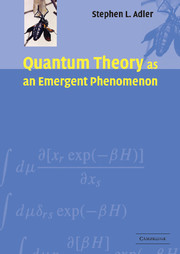 Quantum Theory as an Emergent Phenomenon
Quantum Theory as an Emergent Phenomenon Book contents
- Frontmatter
- Contents
- Acknowledgements
- Introduction and overview
- 1 Trace dynamics: the classical Lagrangian and Hamiltonian dynamics of matrix models
- 2 Additional generic conserved quantities
- 3 Trace dynamics models with global supersymmetry
- 4 Statistical mechanics of matrix models
- 5 The emergence of quantum field dynamics
- 6 Brownian motion corrections to Schrödinger dynamics and the emergence of the probability interpretation
- 7 Discussion and outlook
- Appendices
- References
- Index
1 - Trace dynamics: the classical Lagrangian and Hamiltonian dynamics of matrix models
Published online by Cambridge University Press: 17 March 2010
- Frontmatter
- Contents
- Acknowledgements
- Introduction and overview
- 1 Trace dynamics: the classical Lagrangian and Hamiltonian dynamics of matrix models
- 2 Additional generic conserved quantities
- 3 Trace dynamics models with global supersymmetry
- 4 Statistical mechanics of matrix models
- 5 The emergence of quantum field dynamics
- 6 Brownian motion corrections to Schrödinger dynamics and the emergence of the probability interpretation
- 7 Discussion and outlook
- Appendices
- References
- Index
Summary
In this chapter we set up a classical Lagrangian and Hamiltonian dynamics for matrix models. The fundamental idea is to set up an analog of classical dynamics in which the phase space variables are non-commutative, and the basic tool that allows one to accomplish this is cyclic invariance under a trace. Since no assumptions about commutativity of the phase space variables (such as canonical commutators/anticommutators) are made at this stage, the dynamics that we set up is not the same as standard quantum mechanics. Quantum mechanical behavior will be seen to emerge only when, in Chapters 4 and 5, we study the statistical mechanics of the classical matrix dynamics formulated here.
In Section 1.1, we introduce our basic notation for bosonic and fermionic matrices, and give the cyclic identities that will be used repeatedly throughout the book. In Section 1.2, we define the derivative of a trace quantity with respect to an operator, and give the basic properties of this definition. In Section 1.3, we use the operator derivative to formulate a Lagrangian and Hamiltonian dynamics for matrix models. In Section 1.4, we introduce a generalized Poisson bracket appropriate to trace dynamics, constructed from the operator derivative defined in Section 1.2, and give its properties and some applications. Finally, in Section 1.5 we discuss the relation between the trace dynamics time evolution equations, and the usual unitary Heisenberg picture equations of motion obtained when one assumes standard canonical commutators/anticommutators.
Bosonic and fermionic matrices and the cyclic trace identities
We shall assume finite-dimensional matrices, although ultimately an extension to the infinite-dimensional case may be needed. The matrix elements of these matrices will be constructed from ordinary complex numbers, and from complex anticommuting Grassmann numbers.
- Type
- Chapter
- Information
- Quantum Theory as an Emergent PhenomenonThe Statistical Mechanics of Matrix Models as the Precursor of Quantum Field Theory, pp. 21 - 38Publisher: Cambridge University PressPrint publication year: 2004


